

11/2005
Business conditions in residential markets strong but easing as year progresses
by
Kermit Baker, PhD, Hon. AIA
Chief Economist
A strong housing market for more than a decade has pushed construction activity in most metropolitan areas to increasing distances from downtown areas. Although these development patterns offer greater opportunities for land at more reasonable prices, they create problems in terms of longer commutes to employment opportunities as well as less accessibility to shopping, public transportation, recreational opportunities, and other services.
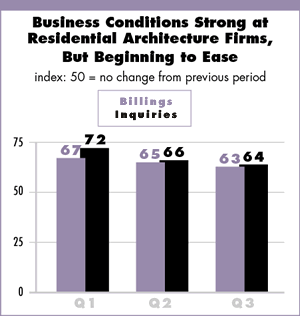 Residential architects report greater emphasis on providing these opportunities
in emerging communities. They also report more attention to energy conservation
issues in many of the products that households are selecting for their
homes. Energy-efficient products (such as triple-glazed windows) are
growing in popularity with rising energy costs, as are recycled materials.
Additionally, residential architects report growing interest in synthetic
and engineered building products (such as countertops, flooring, and
decking) due to the lower maintenance required in most instances.
Residential architects report greater emphasis on providing these opportunities
in emerging communities. They also report more attention to energy conservation
issues in many of the products that households are selecting for their
homes. Energy-efficient products (such as triple-glazed windows) are
growing in popularity with rising energy costs, as are recycled materials.
Additionally, residential architects report growing interest in synthetic
and engineered building products (such as countertops, flooring, and
decking) due to the lower maintenance required in most instances.
Business conditions healthy but easing
Signs are beginning to emerge that the housing market may be nearing
its peak in many areas. Inventories of new and existing homes are beginning
to grow, higher house prices are pushing down the share of homebuyers
who can afford to purchase homes, and mortgage applications to purchase
homes appear to be beginning to wane a bit.
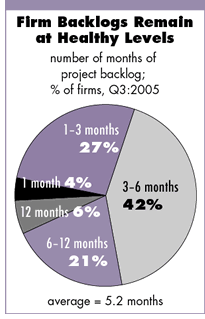 Residential
architects also are reporting signs of an easing in the residential market.
Both billings on existing projects and inquiries for new projects are
very strong, with scores of 63 and 64 respectively on an index in which
any reading above 50 indicates growth in activity. However, both scores
have declined steadily throughout the year. Some of the decline may be
a normal slowdown reflecting seasonal trends in residential construction
activity. However, in all likelihood, the activity levels reported by
architecture firms do indicate some modest impending slowdown in residential
activity. This is concurrent with the AIA’s Architecture Billings Index
(ABI) showing that architecture
firms in general jumped in September even while the housing
market was cooling. Research conducted by the AIA has found that changes
in design activity precede changes in construction activity by almost
two quarters. Recent increases in design activity can be expected to
produce similar changes in construction activity in early 2006.
Residential
architects also are reporting signs of an easing in the residential market.
Both billings on existing projects and inquiries for new projects are
very strong, with scores of 63 and 64 respectively on an index in which
any reading above 50 indicates growth in activity. However, both scores
have declined steadily throughout the year. Some of the decline may be
a normal slowdown reflecting seasonal trends in residential construction
activity. However, in all likelihood, the activity levels reported by
architecture firms do indicate some modest impending slowdown in residential
activity. This is concurrent with the AIA’s Architecture Billings Index
(ABI) showing that architecture
firms in general jumped in September even while the housing
market was cooling. Research conducted by the AIA has found that changes
in design activity precede changes in construction activity by almost
two quarters. Recent increases in design activity can be expected to
produce similar changes in construction activity in early 2006.
Backlogs also easing
Like business conditions, project backlogs are very healthy, but also
seem to be easing a bit. Residential architecture firms report 5.2
months of project work in-house, down just 0.2 months from the second-quarter
estimate. Twenty-seven percent of firms report over six months of work
in-house.
Despite generally strong conditions in the residential market, there is considerable variation across the different segments. During the third quarter, as has been the case throughout the year, residential architects rated home improvement projects—home additions and alterations, and kitchen and bath remodels—at the top of the list. For each of these activities, around 40–45 percent of respondents indicate that conditions are improving, while only 6–7 percent feel that conditions are weakening.
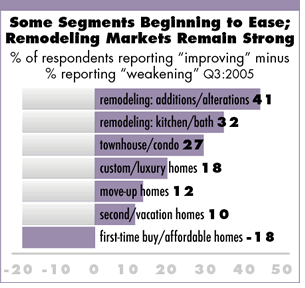 Townhouses and condominiums also are rated as generally improving. This
sector has benefited from the recent growth in homeownership rates, as
these homes are often the most affordable in many markets. Additionally,
they appeal to a broad population base because of the minimal maintenance
obligations. The more traditional custom/luxury and move-up housing segments—as
well as second and vacation homes—are showing some strength, although
conditions in all three of these markets have eased from the beginning
of the year.
Townhouses and condominiums also are rated as generally improving. This
sector has benefited from the recent growth in homeownership rates, as
these homes are often the most affordable in many markets. Additionally,
they appeal to a broad population base because of the minimal maintenance
obligations. The more traditional custom/luxury and move-up housing segments—as
well as second and vacation homes—are showing some strength, although
conditions in all three of these markets have eased from the beginning
of the year.
The weakest segment, and the only segment that more residential architects rate as weakening than improving, is homes targeted for first-time buyers. These households often have the least resources to absorb the rising prices we’ve seen in the housing market in recent years. More than a third of respondents rate this segment as weakening, and only 16 percent rate it as strengthening.
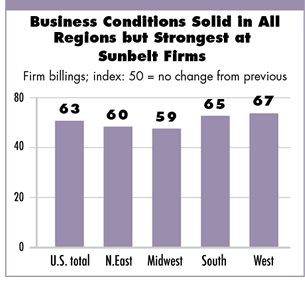 Housing market conditions regionally remain relatively stable. Billings
are improving slightly more at firms in the South and West, but firms
in the Northeast and Midwest also reported healthy conditions in the
third quarter.
Housing market conditions regionally remain relatively stable. Billings
are improving slightly more at firms in the South and West, but firms
in the Northeast and Midwest also reported healthy conditions in the
third quarter.
Integrated uses and greater accessibility
key to community design
The residential construction surge that we’ve seen in recent years
has greatly expanded the development boundaries in many metropolitan
areas. In an effort to find affordable building lots of sufficient size
to appeal to homebuyers, residential construction activity has moved
to significant distances from the core of urban areas. This increasingly
has isolated these new occupants from employment opportunities, commercial
activities, public transportation options, and other critical services
such as health care.
In response, neighborhood and community design strategies are aimed at addressing these concerns. Infill development, where smaller parcels closer to the urban core are targeted for development, is seen almost universally by residential architects as a strategy increasing in popularity.
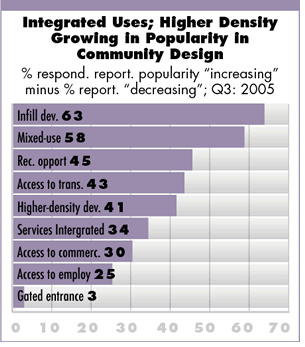 Other than emphasizing infill development, community design trends are
moving toward integrating more activities into the development. Mixed-use
projects, which include commercial and retail activities, are overwhelmingly
seen as increasing in residential developments. Increased recreational
opportunities (walking trails, exercise centers), higher-density development
(smaller lots), and services provided on site (e.g., health care and
convenience stores) also are strategies to reduce the isolation of more
distant residential development.
Other than emphasizing infill development, community design trends are
moving toward integrating more activities into the development. Mixed-use
projects, which include commercial and retail activities, are overwhelmingly
seen as increasing in residential developments. Increased recreational
opportunities (walking trails, exercise centers), higher-density development
(smaller lots), and services provided on site (e.g., health care and
convenience stores) also are strategies to reduce the isolation of more
distant residential development.
In addition to providing more activities, accessibility to other opportunities are also increasing when considering community design and location. Access to public transportation and alternative transportation systems such as bikeways and walkways were seen by many respondents as strategies that are more popular. Likewise, proximity to commercial shopping and employment are more generally emphasized. With more concern on integration and accessibility, gated entrances and distinctive community entrances are waning in popularity.
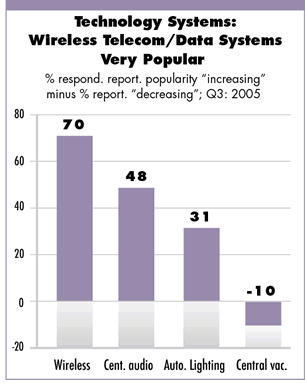 Wireless technology, energy-efficient products increasing in popularity
Wireless technology, energy-efficient products increasing in popularity
More technological options are available to consumers in their homes
today. As households increasingly are adding or converting space in
their homes for home offices, it follows that there also is growing
interest in wireless telecommunications and data systems in the home.
More than 70 percent of residential architects saw this trend growing
in popularity; almost none saw it as decreasing. Central audio systems
and automated lighting control systems are other systems seen as growing
in popularity.
Previous AIA Home Design Surveys documented the growing popularity of energy management, security, and fire safety systems in the market. Given rising energy costs, it’s not surprising that energy-efficient products are seen by two-thirds of respondents as growing in popularity. The increased use of synthetic and engineered materials and products reflect a parallel trend in makings products more durable and requiring less maintenance.
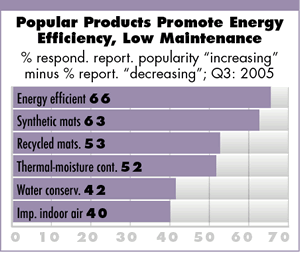 Greater
use of recycled and salvaged materials, as well as interest in water-saving
products no doubt reflects growing environmental sentiment among consumers.
However, it may also reflect that more of these products are readily
available on the market, and, in the case of water-saving products, the
rising cost of water and sewer services. Finally, growing recognition
of problems of mold and indoor air quality has heightened interest in
thermal-moisture control systems (for mold) and products promoting improved
indoor-air quality.
Greater
use of recycled and salvaged materials, as well as interest in water-saving
products no doubt reflects growing environmental sentiment among consumers.
However, it may also reflect that more of these products are readily
available on the market, and, in the case of water-saving products, the
rising cost of water and sewer services. Finally, growing recognition
of problems of mold and indoor air quality has heightened interest in
thermal-moisture control systems (for mold) and products promoting improved
indoor-air quality.
Copyright 2005 The American Institute of Architects.
All rights reserved. Home Page ![]()
![]()
 |
||
|
||